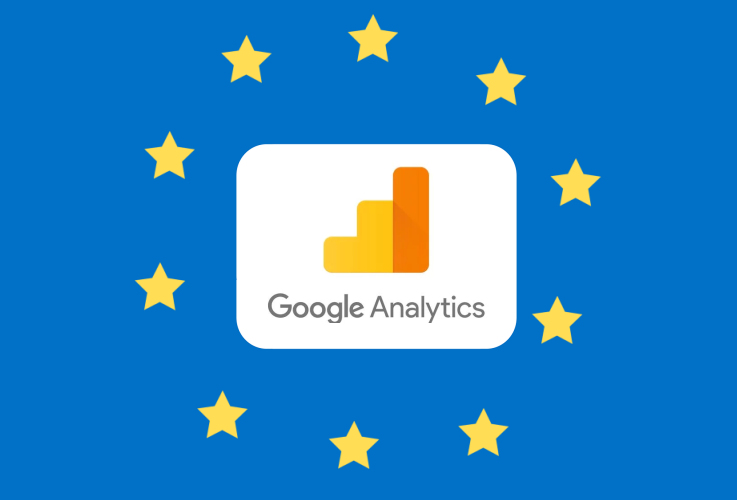Google Search Console, formerly Google Webmaster Tools, allows you to see your website less as a subjective observer, and more as Google sees it. Since Google uses several hundred factors to determine how your website ranks for specific search terms, it is important to understand how it interprets your website's pages so that you can address any issues and make incremental improvements - or, in other words, so you can optimize your website for search engines (Search Engine Optimization or SEO).
If you don't already have it enabled, it's easy to get started with Google Search Console. Firstly, you should check whether anyone else associated with your website, such as your web designer, has already set this up for you. If not, once you have created an account simply add your own website and verify that you own it by using one of the methods provided.
Here are ten key aspects of the Google Search Console to pay attention to:
1. HTML Improvements
Under the "Search Appearance" header on the left menu, the HTML Improvements section will outline which, if any, of your website's pages require improvements to their "meta data" (HTML tags within your pages that are used by search engines to help identify what your pages are about). This includes meta descriptions, meta titles and whether or not any of your website's pages cannot be indexed/spidered (being discovered and ranked) by Google for some specific reason. It is imperative to address any issues identified on this page, as they are fundamental to your website's search engine rankings.
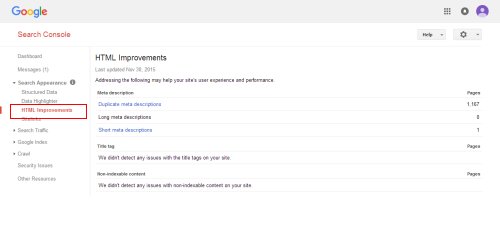
2. Search Analytics
Under the "Search Traffic" header on the left menu, the Search Analytics section gives you a remarkably detailed view of how your website's pages perform in search results. Some areas to pay attention to include:
- Identify which pages of your website are ranking highly but are not enjoying a high Click-Through Rate (CTR). You may want to improve the meta description of these pages to encourage searchers to click on your website in results.
- Identify which pages have a high Click-Through Rate (CTR) but are not ranking well, and concentrate on trying to get other high quality websites to link to these pages to improve their ranking.
- Identify which pages of your website are ranking at just above tenth in results. Often called "low hanging fruit", these are pages that may require only slight optimization to be ranked on page one of search results and significantly increase the number of visitors generated.
- Identify what kinds of content or content subjects are ranking most highly. If you regularly publish content to a blog or equivalent feature, you can tailor your future work to closely match these high-performing pages.
- You can click on individual search terms that you feel are important to your website to view what pages are highest ranked and get the most clicks for specific terms. This tells you which pages of your website Google considers most relevant for these search terms, giving you the opportunity to learn why this is the case and optimize pages further.
- Identify the keywords for the most-visited pages of your website and use them when you publish new content or engage in a link-building campaign. You can also further optimize such pages by making sure they include all the natural variations of the keywords involved.
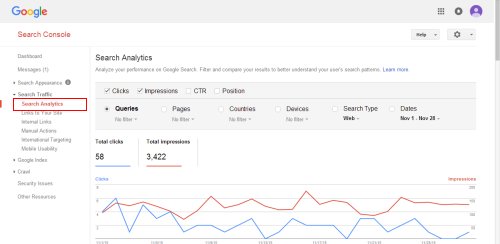
3. Links to Your Site
Also under the "Search Traffic" header on the left menu, the Links to Your Site section provides an overview of the links to your website. The total number of links identified by Google is shown at the top, but this can include many from just the same website. You can view which websites link to you the most, what pages of your website they link to, and in what context they exist (the words used to link). This can help you understand which links are of most value to your SEO work, and whether you need to improve your link-building efforts.
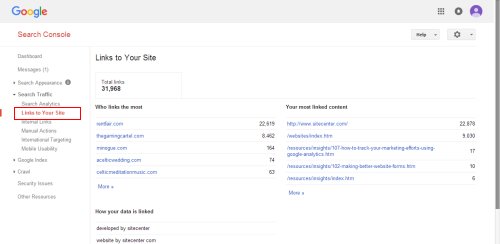
4. Manual Actions
The Manual Actions sub-menu can also be found under the "Search Traffic" header on the left menu. Most website owners and administrators will not find anything here, but if you do you must act on all the recommendations. If you have ever been convinced to pay for cheap SEO services that made unrealistic promises, the chances are your website's rankings will have been affected by Google's "Penguin" algorithm update, which penalized websites for having unreasonable quantities of "unnatural" incoming links. If this is the case, links identified by Google as being suspicious will be identified in this section and you must take action either by asking the offending website to remove the link, or by following the instructions to "disavow" such links.
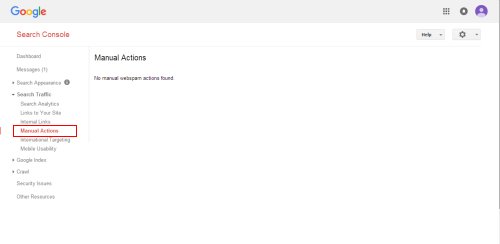
5. Mobile Usability
The last sub-header under the "Search Traffic" header on the left menu indicates whether or not your website is "mobile-friendly". Since April 2015, Google has ranked websites that are optimized for smaller screen-sizes higher than other websites when searches are performed on mobile devices - so to have maximum impact a website should be optimized for all screen sizes. This section identifies just how optimized your website is for smaller screens and what issues require attention.
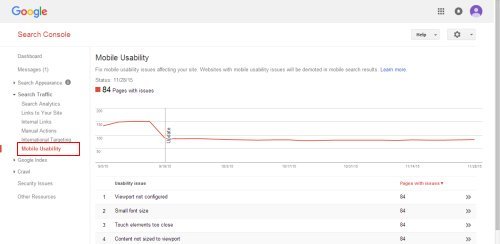
6. Index Status
The first sub-header under the "Google Index" header on the left menu provides useful information about how well Google has indexed your website. An indexed page is a page that Google has discovered, analyzed and returns in search results, even if the page has such a low ranking that it never attracts any visitors from search results. If you think the number of pages indexed by Google is a poor reflection of the total number of pages your website has, it is useful to see if your "robots.txt" file (a small text file that should be in the top-level directory of your website that can contain directives aimed at search engines) is blocking Google from any pages by clicking on the Advanced tab. In most cases, you will need to fix your robots.txt file if it instructing Google not to index a large proportion of your website's pages. If your robots.txt file is not blocking any pages, but a large number of your pages are not being indexed, other tools in the Search Console should prove useful.
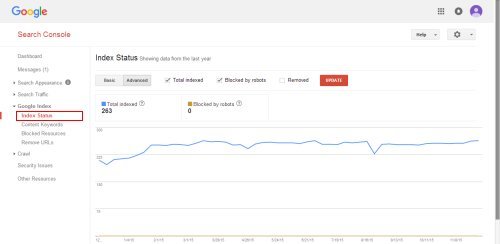
7. Crawl Errors
One of the most effective ways to optimize your website for search engines is to make sure that it does not contain errors. Broken links, for example, not only provide for a bad user experience but they suggest that a website is of low quality and poorly maintained. For this reason, search engines will not rank websites that have lots of errors highly. This first section under the "Crawl" header on the left menu shows you any errors that Google has discovered while indexing your website. It is important to note that no matter how well maintained your website is, there will usually be at least a few errors discovered here, since Google may discover links from other websites to content on your website that no longer exists. If you discover that your website suffers from any errors listed under the Site Errors section, or has errors other than "Not found" under the URL Errors section, it will definitely be worth your time to investigate and fix these problems.
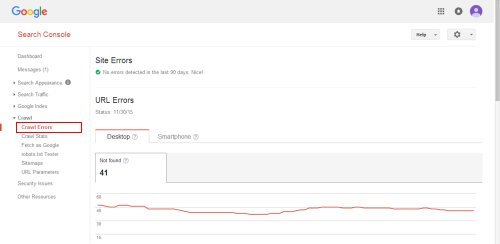
8. robots.txt Tester
The fourth sub-header under the "Crawl" header on the left menu indicates whether or not there are any errors or warnings with your website's robots.txt file. It is not only critical that you address any issues identified, but since this page also displays your robots.txt file's actual content, you can check whether you see any files or folders being blocked from indexing by Google (signified by the "Disallow" directive) that you don't think should be. If you don't think Google is indexing a good proportion of your website's pages, your robots.txt file may be to blame.
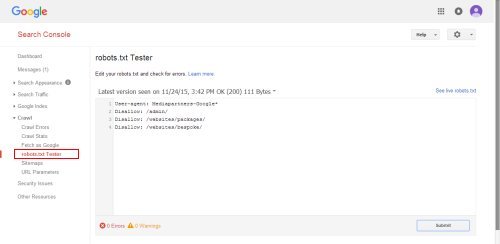
9. Sitemaps
One of the most important aspects of your SEO activities should be ensuring that as many of your website's pages as possible are indexed by Google, and one of the best ways to accomplish this is to have an XML sitemap for your website. This is a file that should be located in the top-level directory of your website that lists all of the pages of your website you want Google to discover, written in XML format. You can see if Google knows about your XML sitemap by visiting the Sitemaps section under the "Crawl" header on the left menu. If your website has an XML sitemap but it is not listed here, you should submit it as soon as possible. Once Google has discovered your XML sitemap, you can see how many pages that are in your sitemap have actually been indexed by Google (it is not normal for Google to index 100% of the pages in your XML sitemap). It is important to note here that even if your website does not have an XML sitemap, or if it does but it is not listed here, it is still likely that Google will have indexed most of your website's pages.
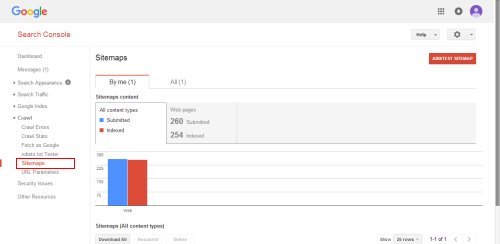
10. Security Issues
By clicking on the "Security Issues" header on the left menu you will be able to see if Google has identified any potential security threats from your website. This may include security flaws that have been found in common website software (such as for bulletin boards or image resizing) or that emanate from advertising that has been shown on your website. In all cases it is imperative that you address any issues, since Google may initially display a security warning to users alongside your search results (discouraging them from clicking),and may eventually remove your website from it's results altogether.

Conclusion
As we have seen, the Search Console provides a transparent view of what Google thinks about various aspects of your website's SEO health. If you fix any issues identified, your website will almost certainly enjoy higher rankings and subsequently increased traffic from search engines. You should also login to the Search Console regularly to analyze your Search Analytics and tailor your approach to publishing new content accordingly.


